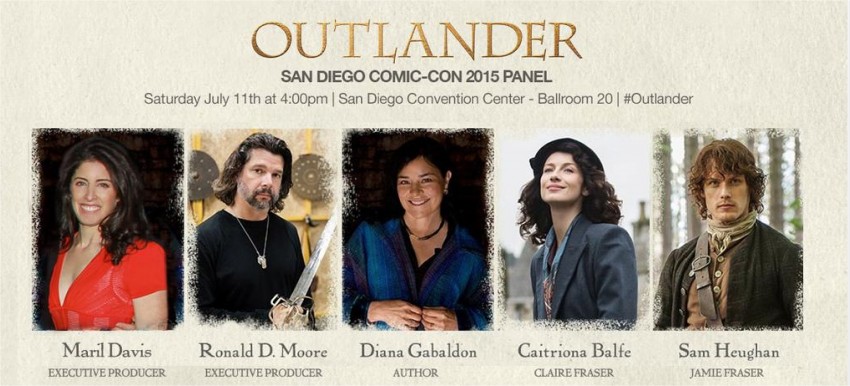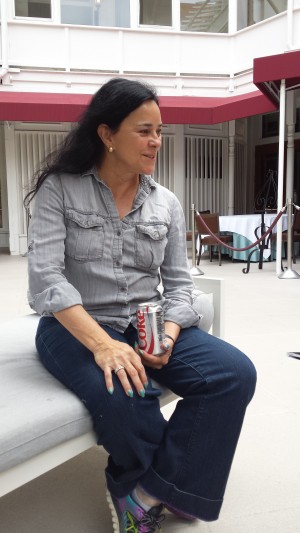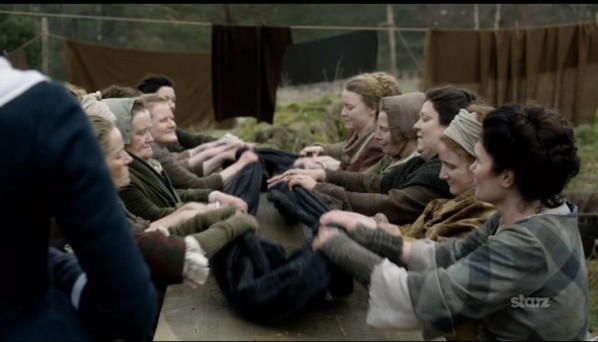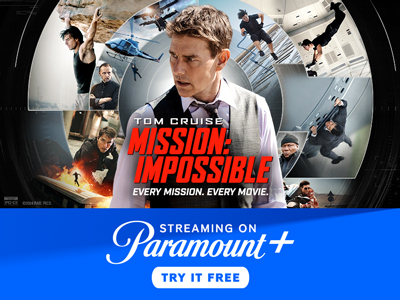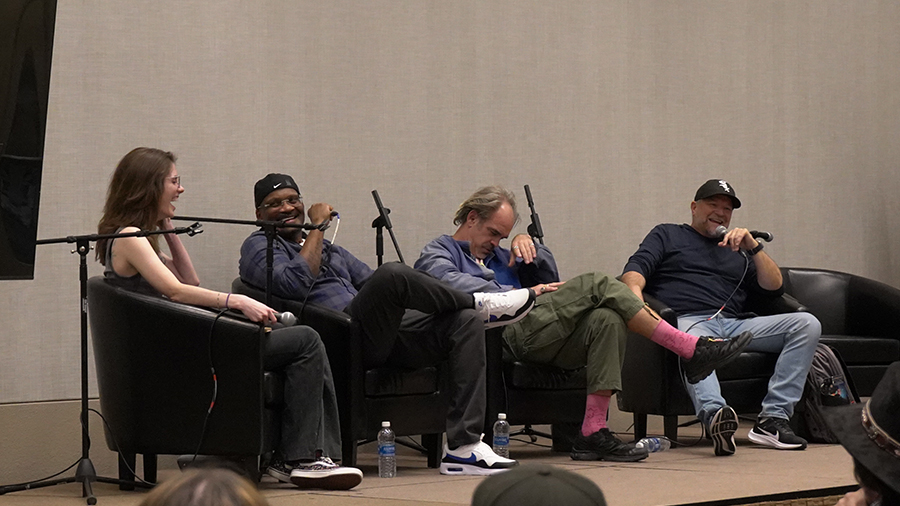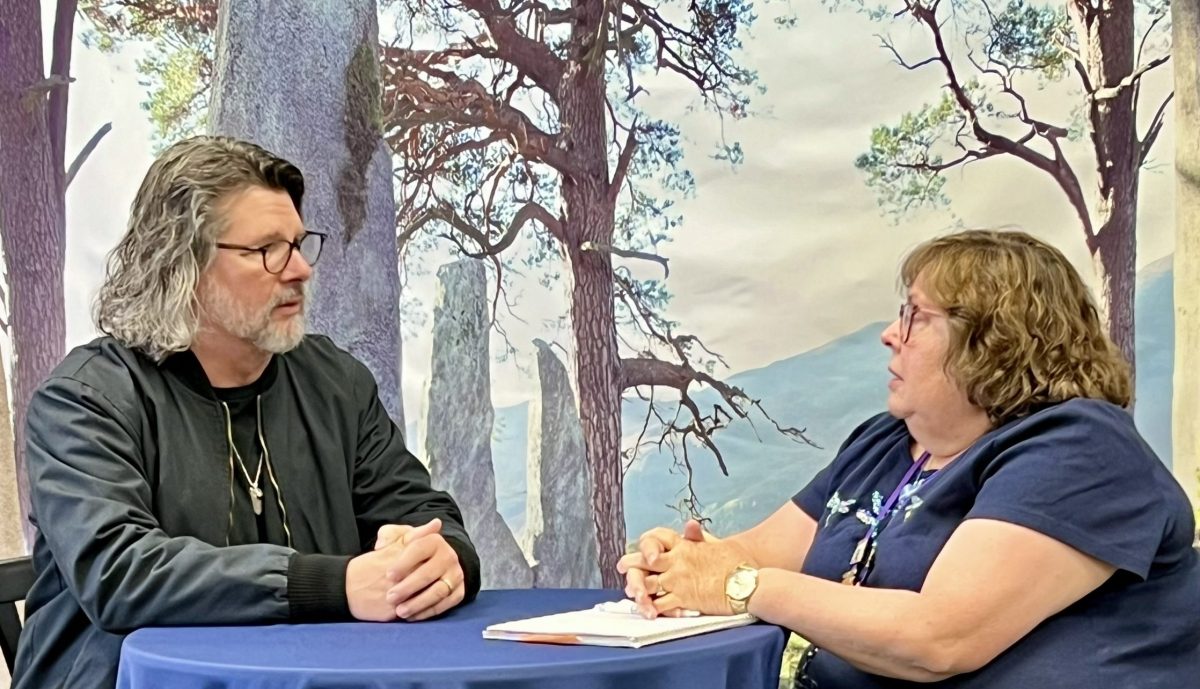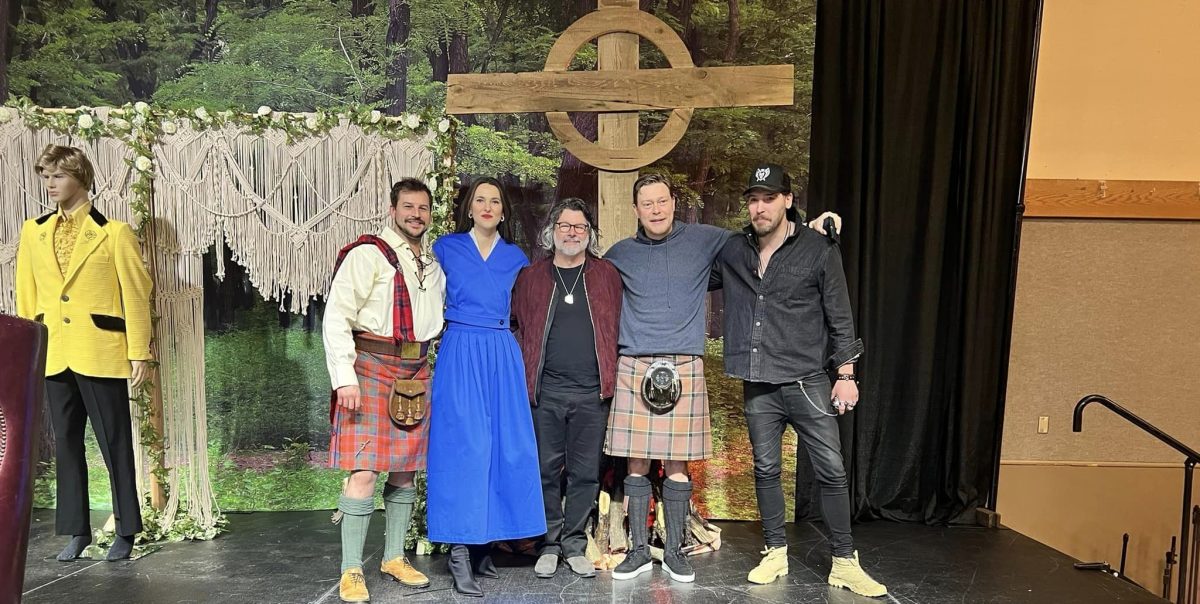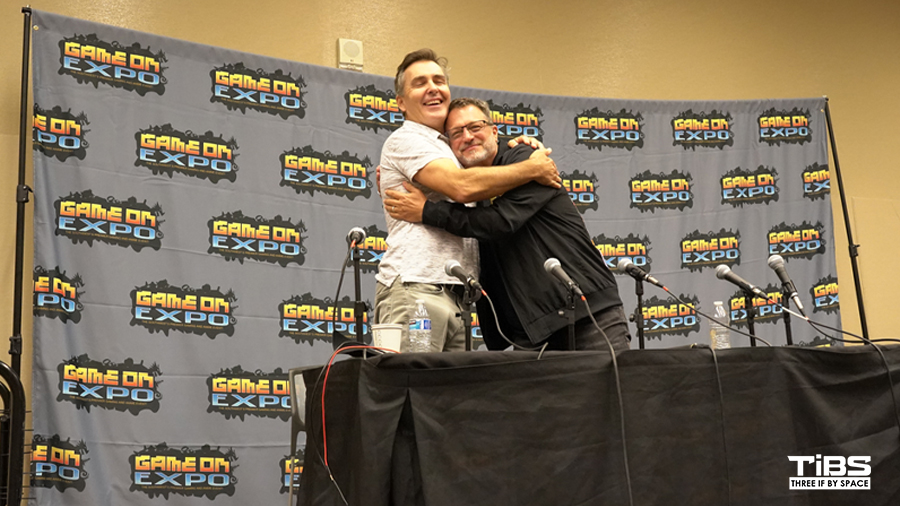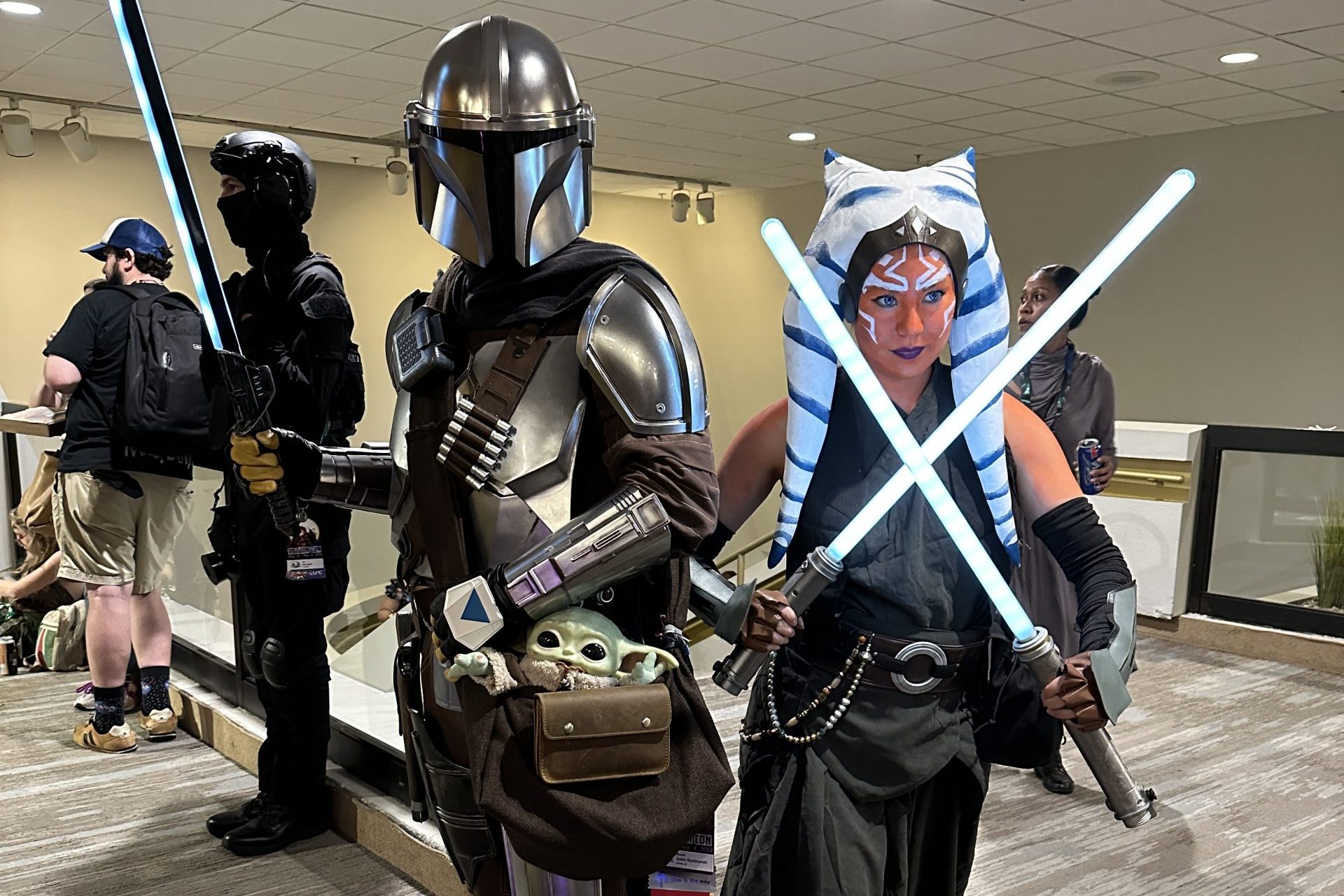In part 3 of my ComicCon Outlander coverage, our table of bloggers and reporters talked with Diana Gabaldon about the show, the books, the connections between the two, and her “crazy” fans. Diana was very relaxed, laughed with us, and was very forthcoming about her social media engagement. As always, she was poised, friendly and elegant. I asked her about her own literary influences. And be sure to get to the bottom, where I asked Diana a bonus question during a personal interview.
Q When you started writing, who were your literary influences, and how do you feel about now being a literary influence yourself?
A I had five literary influences, who I was consciously taking craft from , and those would have been Charles Dickens, Robert Louis Stevenson, Dorothy L. Sayers, John D.MacDonald, a thriller writer, from him I learned the narrative drive and pacing, and how to control a series character, and P.G. Wodehouse, a British comic novelist who is just fabulous with manipulations of language, and a lot of Claire’s, the way she talks, and her interior monologue.
Q And then how do you feel about being an influence – like Gen Graham has said she started her novels because of your writing.
A I’m extremely flattered that they could take anything from me, they’re more than welcome to it.
And questions from the other reporters at the roundtable:
Q As we wait to see who will be cast as Brianna and Roger, what are some of their individual characteristics you are looking forward to being brought to the screen?
A Well, it’s hard to say because so much of it depends on the actor and what they can do. Now, Sam for instance is a very analytical actor, and he has read the books several times, and you can see him do Jamie’s little physical things, like drumming his fingers when he’s thinking, and so forth, and those are conscious decisions. At the same time, you instantly grasp the emotional sense of Jamie. The very first time I saw him in an audition tape, I never thought they would find anyone who could do that, and they did, just like that. At the same time, there’s a certain Sam-ness to him. It’s very weird to be sharing joint custody with a character. And on the other hand, Cait is completely different. It took them forever to find a Claire. You’ve probably heard the story about how they picked her out of the slush pile, and she just walked into that part and inhabited it. Her physique is not as described in the book, but it doesn’t matter. I’ve always said to people that it doesn’t matter that much what an actor looks like, it’s how they act. She totally inhabits it.
Q Book 2 starts at a surprising place, compared to Book 1.
A A lot of people think they’re reading the wrong book.
Q When the plotting of Season 2 began, what were the discussions about how it would start? Starting with Bree and Roger is obviously not going to happen.
A Well, they actually could, because they shoot things out of sequence. That doesn’t actually tell you anything, except that they haven’t cast anybody in the parts, at least they haven’t told you yet. Actually, I was not involved in the discussion of how to break the story, so to speak. They do show me the script outlines and the scripts, they show me the footage that they shoot and the rough episodes as they come together, which is great. I love to see that. But I very seldom am actually in the writers’ room discussing things with them. It’s their job. And I’m happy to contribute things, you know, sometimes I’ll read a script and I’ll say, “mmmm, I understand why you did it this way, but you could get more of the actual book in and move this little piece over here,” and sometimes they’ll do that. Bu 9 times out of 10, if I have a concern or a suggestion, they’ll take it. And the 10th time they’ll explain why they can’t.
Q You have said in several interviews that you have tried to fight for certain sequences and that doesn’t always work out, like the hot springs scene. Has there been a point at which you tried to assert control?
A You can’t. Unless you’re JK Rowling.
Q Or EL James, in 50 Shades.
A Maybe she shouldn’t have. I don’t actually think that’s a good thing, on the whole. An adaptation is a separate art form unto itself. And what makes a good novelist is not necessarily what makes a good screenwriter or showrunner. I don’t know whether I’d be good at writing a script because I haven’t done it yet. But I’m positive I would not be a good showrunner. So I think it’s much better to let the experts do that. I can handle the details, you know, I can tell them this is correct historically, or you can’t do that historically, or it really was this way, but I see why you’ve done it this way, or maybe change this for a little more accuracy, that can be helpful, but I totally don’t want to be in control.
Q Has the show influenced any of your writing?
A Well, really no. People ask that all the time, and I can see why, but they’re working 30 years behind, and there’s 8 books between me and them, and I’ve written all this stuff in between. What exactly would I change in the books? What exactly would I change in the 9th book, and these people are now in their 60s, that would be affected by what these people are doing now? There’s just no way that that could happen.
Q Is your viewpoint affected by the actors playing these characters?
A No, I can still see the original Jamie and Claire. It’s fun to watch Sam and Caitriona, and they’re totally Jamie and Claire when I’m watching the show, but I don’t have any trouble with show vs. book, and I can easily carry both images in my mind.
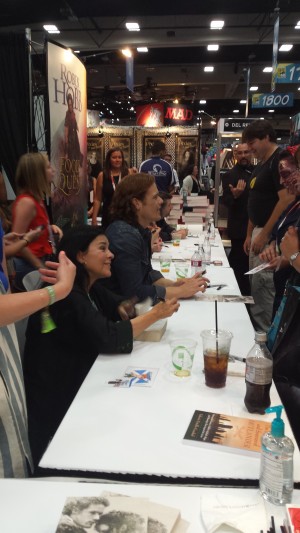
A Well, there are ways of engaging on social media. The thing is, I’ve always been in the middle of it. I was on Compuserve’s literary forum in 1985, so the social media has just more or less grown up around me, as new bits and technologies came along, I’ve just picked out the bits that were useful to me. Tumblr, Pinterest, they don’t really offer me anything so to speak, so I don’t do them. I do Twitter because it’s good for getting out quick messages to people, and collecting the fans if you need to rally them for something. Facebook, I love to stay in touch with people, I have a website which is sadly neglected, but I need to move my stuff from Facebook to there as well so that the website is more of a repository or an archive of information.
When I first knew Sam Heughan, I was sending him some stuff that the fans were saying, and he came back and said, “Your fans are crazy. How do you deal with this?” (reporters at table laugh) So I said, “There’s a way, and I will tell you.” He was on Twitter, and that’s how we met. So I said, “Look, you take 10 minutes, twice a day, or only once if that’s all you can afford, and you go on it every day. And you don’t have to try and read everything addressed to you, or pertaining to you, but go through as much as you can in 10 minutes. If someone says it’s their birthday, stop and say happy birthday. If someone says my dog just died, stop and say you’re sorry. If someone says something witty to you, and something witty occurs to you, stop and say it back. And when you get to the end of 10 minutes, stop. But the fact that you do it every day, and you seem to be responding to people, gives people the feeling that you are actually there all of the time, even though you aren’t.” And it doesn’t eat you alive.
Likewise with Facebook, I post usually once a day, twice if there’s an announcement or something else that I need to add, and I’ll go for a couple of days without sometimes if I’m doing something like this, but I do it regularly, I’ll put up a post. And then the next day, I’ll take 10 minutes and read through the first 2 or 3 screens of comments and reply to the ones that I can easily reply to. And you know, nobody notices that you’re not replying to the ones farther down, because Facebook helpfully moves all the ones that you do reply to up to the top. So anybody looking says “oh look, she’s here, she’s talking to us, this is great.” So it’s partly illusion, and partly .. I just enjoy engaging with people. I like to talk to people about what it is that I do. I always have. I’m a born teacher, and I love to talk to people about writing and craft and how to do things. And now that we have the show, I’m learning so much about how that’s put together, I love to share it with people.
BONUS: The day after this roundtable, I was invited to meet with Diana during a private interview conducted by my good friend Koko Pipkin (outmander.com). As soon as that complete interview is available, I’ll be sure to let you know about it, but at the end of our conversation, I asked Diana one more question.
Q Was there anything in all the changes that Ron made that you particularly liked? There were some little changes, and there were some really big changes.
A I liked most of them. I don’t know what exactly. Parts of the Rent episode where they were traveling, that was changed quite a bit from the book, just because of the time frame and so forth. But there was the part where Claire wanders off and falls in with the village women, so they had changed that, as it was written in the original script, it had Claire in a village that was like Crainesmuir – you know, cobbled streets, houses, and she was walking along and sees a vase in a window, and the woman comes out to talk to her about it, and invites her in, and she ends up playing bridge, and having tea with the village women.
And I’m sort of going, “no, 18th century, remote Highlands, Scotland, no, we can’t do that.” I said, “I understand what you’re trying to do here, but they wouldn’t have had tea, they wouldn’t have had cards, much of Scotland considered cards to be wicked until the middle of the 20th century, and most of all, women would not have been sitting around recreating during the day. Everybody worked, you know, from dawn to dark, and they would have been doing most of outdoors, I knew what women would have been doing at that point, I could give you a list of chores,” so I did. And I said the most picturesque thing, probably, for your purposes, might be wool waulking. And I told him what that was, and how it worked, and that there were these traditional songs, and that might be filmable, if they could find somebody to do that for them. And so they went off and promptly found the Newtonmore Highland Folk Museum, a bunch of reenactors who do those things, and so that worked out really beautifully. So you know, that was their change, but I changed it to fit to the circumstances. It’s been a very good back and forth thing.
Follow me on Twitter: @OutlanderTiBS, @ErinConrad2, and @threeifbyspace
Like us on Facebook or subscribe for instant notice of new posts
Share this post using our Social Share buttons above!

